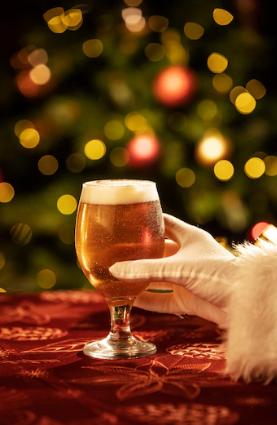For many beer enthusiasts, there’s nothing quite like the taste of a seasonal craft beer. That’s why it makes sense to try creating your holiday season beer if you’re a home brewer. Brewing your seasonal winter beer can be an enriching activity.
You will better understand the brewing process and enjoy the fruits of your labor when it comes time to drink!
Let’s break down how to start brewing your seasonal winter beer.
Winter Seasonal Beers
What’s good about Christmas cookies and eggnog? They’re seasonal! Winter-season beers bring the same kind of anticipation. Seasonal winter beers are often dark and malty, with a hint of spice.
The dark malts will give your beer a deep color and toasty flavor, while the spices can add unique complexity to your brew. Common spices in winter beers include cardamom, ginger, cinnamon, and nutmeg.
Brewing a Christmas or Winter Beer, all winter beers start with the choice of a base beer. The base beer can vary widely.
For spiced beer, it is often a moderately dark, alcoholic beer (often an Old Ale) that is well hopped and provides warmth, a good body, and some complexity of flavor to complement the cold weather and choice of spices.
Many first-time holiday brewers go overboard with spices or adjuncts and add too much – overwhelming the base beer rather than accenting it.
Many also try to throw too many spices or flavors into the beer, muddying the final effect and producing a flavorful mess.
The combinations that go best together are those that reflect the flavors of the holiday. Bitter orange peel and cloves, cinnamon and apples, mulling spices and a warm dark beer, fruits to match the spice,
These beers are often built on an American or Belgian base style. US and Belgian brewers often use a slightly modified base beer style.
The resulting beer is usually dark and malty, with a higher level of bitterness and some sweetness from the choice of spices.
Fermentation and Aging
Once your beer is ready, it’s time to ferment and age. The ideal fermentation temperature for winter beers is between 60F-70F. Monitor your fermentation closely, as temperatures can be tricky this time of year.
Once the beer has been fully fermented, you should rack the beer into a secondary vessel and let it condition in the bottle or keg.
Winter beers are typically robust enough to be cellared or stored in a cool, dark place for several months to allow the flavors to integrate and mature.
Brewing a Christmas or Winter Beer
The cold winter season is the perfect time to brew something special—a seasonal beer.
Homebrewing is a great way to explore different flavors, combinations, and techniques to create your unique beverage. I
f you’re new to brewing, don’t worry—it’s not complicated! Here’s how you can brew your holiday beers at home.
Ingredients and Equipment Needed for Brewing
Brewing is an involved process that requires some unique ingredients and equipment.
If you’re starting in home brewing, purchase any needed supplies ahead of time to ensure everything goes smoothly.
Before beginning, you’ll need critical items such as malt extract, hops, yeast, fermentation equipment (like bottles or kegs), and sanitizing agents.
In addition to these ingredients and equipment, you may also want to consider adding spices for flavor or adding adjuncts such as sugar for added body.
Brewing a delicious winter seasonal beer at home can be fun and rewarding!
Gathering all necessary ingredients beforehand, along with appropriate supplies like malt extract, hops, and yeast, followed by partial mash, boiling, cooling, fermenting, carbonating, bottling/kegging—you have everything needed for success!
Brewing Process
Once all the necessary ingredients and equipment are assembled, it’s time to begin the brewing process!
- The first step is mixing all of the ingredients—mashing— to create wort (the liquid base from which your beer will be made).
- The wort is then boiled with hops to extract their bitterness and aromas into the mixture.
- After boiling and cooling down the wort, yeast is added for fermentation over several days or weeks, depending on the type of yeast used and what kind of flavor profile is desired.
- Once fermentation has completed, carbonation occurs during bottle conditioning or by introducing pressurized CO2 into kegs before serving in pubs or restaurants.
Bottling/Serving
Finally, once fermentation has completed and carbonation has occurred, it’s time for bottling/serving!
Depending on whether you choose bottle-conditioning or kegging, as previously mentioned, will determine how long it takes before your home-brewed winter seasonal beer can be enjoyed!
Bottle-conditioning usually takes several weeks, while kegging usually takes 2-3 days before serving.
Regardless of your route, don’t forget that patience is key when making delicious craft beers—so sit back, relax and enjoy!
Enjoy Your Beer
Once your beer is ready, it’s time to bottle and enjoy! Winter seasonal beers can be delightful; from the aromas of the spices to the warmth of the alcohol, these beers are sure to be a hit! Enjoy your creation, and get ready for next season’s brew.
Top 10 Winter Beer Recipes
1. Snow Day Winter Warmer
2. English Old Ale
3. White Christmas Witbier
4. Gingerbread Stout
5. Cranberry Porter
6. Salted Caramel Brown Ale
7. Spice Chai Stout
8. Christmas Ales or Winter warmers
9. Chocolate Orange Imperial Stout
10. Winter Warmer Spiced Lager
Conclusion
Brewing a seasonal winter beer can be an enjoyable experience, from the brewing process to the final product.
You can make your delicious winter beer by having the proper ingredients and equipment, following a recipe closely, and monitoring fermentation temperatures, you can make your delicious winter beer!
This holiday gathering, toast to your winter beer and enjoy it with friends, family, and of course, good cheer!
So grab some friends and family members willing to help with brewing duties and get ready for an enjoyable experience! Who knows? Maybe you’ll discover a new hobby that you never knew existed now!
Enjoy your creation of beer this Christmas season!




